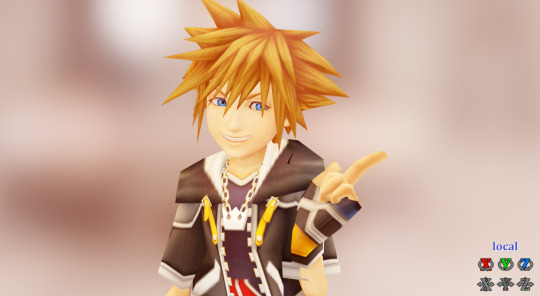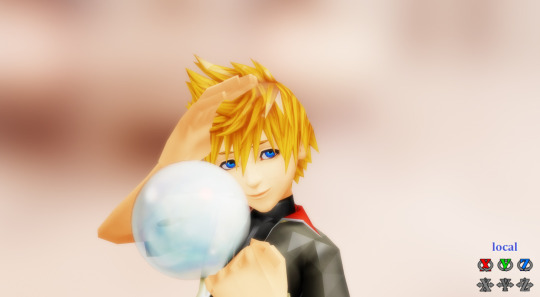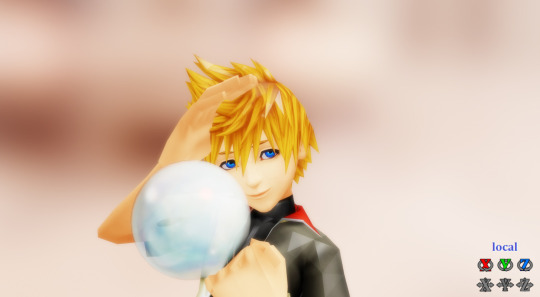#raycastshader
Explore tagged Tumblr posts
Text
Fewmore mmd





Roxas with mmd calculation and roxas with no caculation I can say Raycast does look good on Kingdomhearts I was scared at first too
I think I should try vanitas next I have to admit thats my favorite character even when you like make fun of him like in the battle I kept teasing him that he can't catch and hit me and wellll I died xD
Enjoy da list pack my friends
3 notes
·
View notes
Photo

I am bringing a changed decision about my MMD videos and for my upcoming Randomness 10. The shader tests above are showing you what problems I have when using Raycast (or RayMMD) and telling you guys why I am gonna lay off Raycast for now.
As you guys see, I use Arisumatio's Gloria model and already did all the bones and motions and everything. However, Gloria's hair and accessories are gray and white by default. You can use morph to change the colors, but Raycast so far doesn't work with morphed colors at all, as you see above. While I discuss about Raycast, I will also discuss about HDR10.
First off, Raycast is an advanced shader engine that is been around for last few years, and it can make things look great. Despite that, there are couple of problems.
Raycast has issues with colored morphs as mentioned. I've seen certain models that has a morph that can be a complete black, by turning all of it's color to a one color. However, Raycast does not work with colored morphs unless if the material was already colored on its texture or ambient. I could replace a model that is precolored by textures, but I don't have time to rework with bones or edit all textures for all models, even if I decide to change their colors to make a different person on their hair, clothes, or skin color. Not to mention, Raycast ignores toon texture, so some skin may look desaturated.
Transparency Texture issue. I've seen stages where it has transparent particles, as above. However, Raycast seem to have weird issues with transparent textures where it loses transparency information and can make things blocky, as seen above. It can not blend well to the background and will look often blocky and more flat. I've tried Main_alpha on the objects, and it either doesn't work, or gives me worse results. Last, certain textures receives banding, so it doesn't treat certain texture formats well. Stages with low amount of transparancy textures can look really great, but stages with a couple of transparent textures around can make it look worse than without raycast applied to the scene.
Computer usage and less optimization. I know some bring up that MMD is not as optimized for performance, but Raycast seems to take a larget hit. It's understandable that it's really advanced and have couple of shaders applied with SSAO and Materials. I do have Ryzen 3600 and RX 570 8GB, but it does still show how much usage the CPU and GPU and RAM use, especially when aiming at 4K. I got RX 570 8GB to do 4K videos with Raycast, and it served well. 2GB card can do fine at 1440p, but not anything higher. I've seen heavy scenes in MMD where it uses a bit more than 4GB VRAM at 4K, even lowering shadow textures. The highest shadow texture has a big hit and touches almost 8GB on big scenes, and I've seen other shaders that handles those scenes decently. Despite my setup, I know I can't work with Raycast outside of my Desktop if aiming at anything higher than 1080p. Even using different kind of shaders or shader engine can use a somewhat less usage and memory.
Antialiasing doesn't work well, only post AA. I've made post of my antialiasing methods last year or two to make better quality rendering. Since Raycast uses a different kind of rendering, the MMD's AA does not work at all. FXAA is my only option, but SMAA on any level gives me spikes on some edges. Temporal aliasing does show more by seeing small lines popping and disconnected lines and none of the post AA shaders have temporal antialiasing implemented, like modern DOOM 2016 and Doom Eternal. It looks worse in motion on 1080p and 720p, but 4K minimizes temporal aliasing decently. It really shows when switching to Raycast and you see jagged lines still and disconnections on static motion. 4K looks good enough to reduce it, but I know, like above statement, 4K only works fine on at least 4GB cards.
I would include how long it takes to set up Raycast, but a lot of 3D model programs would take time, unless if you see a recommended preset. Setting it up isn't that big of a deal, but it does take a while when resizing the window or loading the scene. Also, I haven't had enthusiast experience with it, so I don't have a lot of time to research all of it. Even if I tried to fix some errors stated above, it would take more time and testing on post production to see what works best. You would have to test each material shaders. Last minor thing is some effects may not blend well like fire and thunder. My Champion Iris video from April got transparency issue from Raycast on those effects, so it looks glitched. I can't seem to fix it at any way without making it invisible.
So what do I use now? I'm happy with PowerShader v3.2 and it retains the colors of the models better than raycast, even not doing HDR10 or use linear tonemapping. I tried GShader v1.10 at first, but LearnMMD has an article about PowerShader and says it's competitive with Raycast and that it's easier to use and have other effects blend the scene better. I know Raycast is experimental, but I've just uploaded a video about Konata's birthday, and Raycast looks really dull. This time, I don't use my HDR10 method, and while it looks decent, it's kinda disappointing. I wanted to have a constant color gradient and less clipping on colors, but it's really a hassle and too time consuming. PowerShader seems to save more time and more simple to use. I know, materials with bump mapping and reflection gloss will be missing, but there are other shader effects that can perform similarly. AutoLuminous does its job really well, and Hg_SAO and ExcellentShadows2 do too, so I'm more happy to use them. Also, colored morphs works so I get to keep Victor and Gloria models on the scene without a struggle.
Now let's discuss about HDR10 and why I'm deciding not to do more HDR10 content. This was a decision, even before I decide to leave Raycast as Konata's Birthday video was uploaded. My HDR10 Method is only through Raycast. HDR10 is more complicated process than Raycast itself, so the rest will sound complicated.
HDR10 is a lot of work. More work than working with SDR content directly. It's a long process and I have to edit from Sony Vegas and use white text to use 75% of white to not be too bright on displays with over 1000 nits. HDR10 can look good, but editing it and wanting to add pictures over it can be a hassle. Also, I have to use scripts and commandline and x265 pipe to do a single HDR. Not only that, it takes longer to render on HEVC 4K 10bit HDR than HEVC 4K SDR. It's hard to keep full range to x265 so banding is introduced a bit unless if you want the process to be slower to convert to 16bit from Avisynth+. I also have to use BT.2020 colorspace directly to not have colors process poorly. Last, only Avisynth script can do proper HDR tonemapping to SDR. Handbrake doesn't do tonemapping yet and I do want to play the video on my mobile device that doesn't decode HEVC well or do HDR Tonemapping. It's a long process overall.
Making HDR content is a challenge to make it pop well. My methods has improved, admittedly, from Iris goes to Court to Champion Iris video. However, having really bright objects doesn't seem to be that bright to see HDR10 like popping experience. It's kinda challenging to try to pull off really bright effects for HDR. It could be because our HDR TV doesn't go over 400 nits as the minimum standard to see better HDR experience. I've tried going from 300 nits average to 200 nits average, and I couldn't say if I allowed more bright scenes to shine. The tonemapping besides Linear and Reinhard, it desaturates and color shifts too heavily for SDR. I use Hable to fit better for HDR10 method. The desaturation and colorshifts are reduced, but I still see it on some parts of beight objects. The brightest device I could find is my tablet, which is almost 400 nits, but it performs poorly with HDR, even to 1080p 30FPS h264. I don't really have all the tools to do proper experiment by using HDR bright display to test the settings like what most movie studios do. Maybe the developer of Raycast can experiment HDR10 and make a tonemapping for it.
Many people don't make HDR videos currently and many other video sharing websites don't output HDR10. I feel like many people have one or two 4K HDR TVs on their houses, and I know Youtube tonemaps the videos to SDR. Youtube's tomemapping makes very dark spots a little gray. My Miraculous Ladybug Alternative video doesn't look great, and that was when my HDR10 method was experimental. There's not many video editors where you can directly edit in HDR, and it isn't user friendly to test HDR yet so it is the reason why many uploaders don't work with HDR. Making 3D HDR is a rare thing to do currently, and since it's a complicated process, it's not simple enough to have more people make HDR10 content. I realize certain video editors have HDR10 mode, but they are really expensive and not really affordable to mass media.
I do like HDR10 movies and videos, but three things above are the reasons why I wanted to pause my HDR video habits to make it easier to edit my videos and publish it. I'm gonna retire it for now, but I'll share my methods below if you guys want to test it and do a hard work for it or if you decide to share it to others.
Raycast: Hable Tonemapping, Exposure+=0.0, Exposure-=0.7 (200 nits Average Frame) or 0.61 (300 nits Average Frame), Contrast+=0.0, and Contrast-=0.9. Used cLUT shader from BowlRoll and made rec.2020 LUT Texture for HDR10. Average Frame nits=200 or 300 by Exposure settings above, max frame nits=1000, on x265 command line.
I just want to make my editing easier and more simple. My next experiment is gonna be easier and worth doing. I plan to show how to get MMD working on Linux via Wine and PMXEditor and MMEffect. It's a way to have MMD working on other OSes and it's really usable.
Edit 06/03: I also tested N3+C. While it doesn’t work with colored morphing, it doesn’t affect texture transparency, so it’s still a lot better than Raycast. N3+C allows native antialiasing and shadows looks better without worrying about VRAM usage on really high details. N3+C does have a few drawbacks, like colored morphs, but it seems to be generally stable, and allows bump mapping so it can be used on clothes. Lighting would have to take a little work when you first try it, but it looks really good.
0 notes
Video
tumblr
Nothing like making self-indulgent MMD videos on my birthday. B)
Credits below the cut:
Models: http://jakkaeront.deviantart.com/art/MMD-Pokemon-2016-Pack1-DL-643428334 http://jakkaeront.deviantart.com/art/MMD-Pokemon-2016-Pack2-DL-645430882 http://jakkaeront.deviantart.com/art/Tested-new-MM-D-Pokemon-mods-651663010
Motion: http://www.nicovideo.jp/watch/sm28364571 (bless the author for making the motion more compatible with male characters)
Stage: http://supurreme.deviantart.com (DL taken down)
Effects: MotionBlur, likelooks, likeHDR, Diffusion7, RaycastShader
#pokemon#magma leader maxie#team plasma colress#aether branch chief faba#skull boss guzma#mikumikudance#video#MMD
700 notes
·
View notes
Photo


Top was done last week when I was trying to render with the RayCastShader, and the Bottom was last year with NCHL...Sorta a self Comparison, I guess?
Both were edited in Gimp
0 notes
Text
Ventus with a bubble

I was trying
Kingdomhearts on Mmd with Raycaster and these are my results of trying
i credit the person who made this model they did good
Thank you ^U^
0 notes